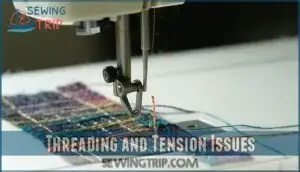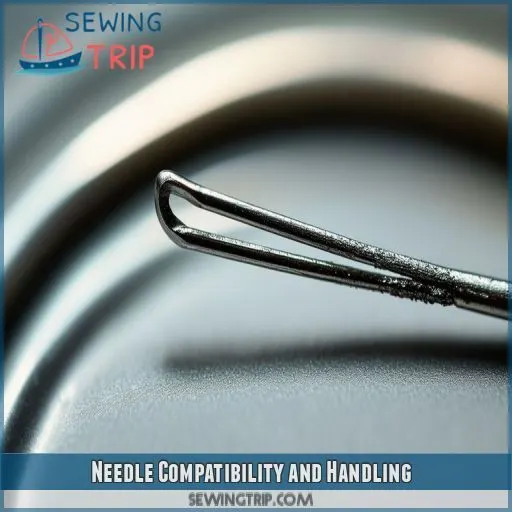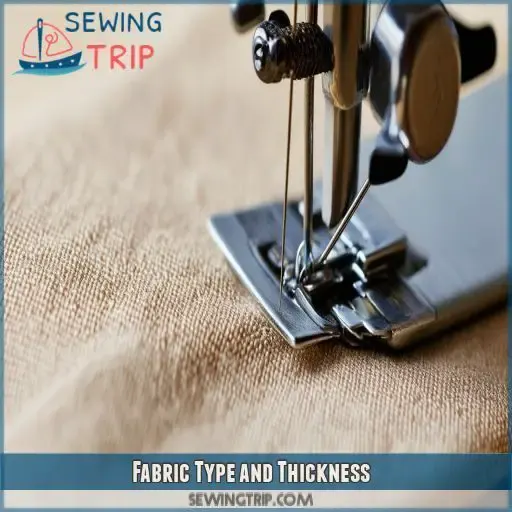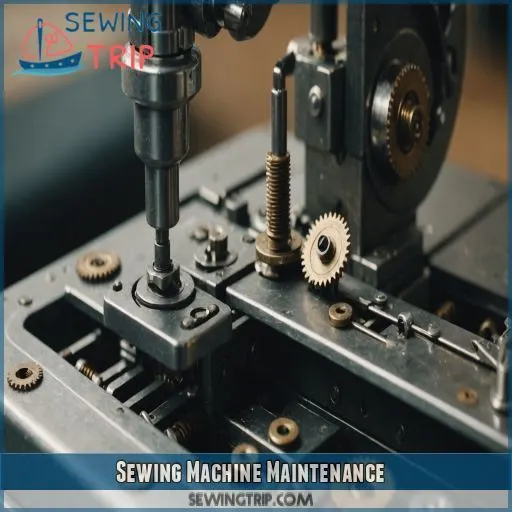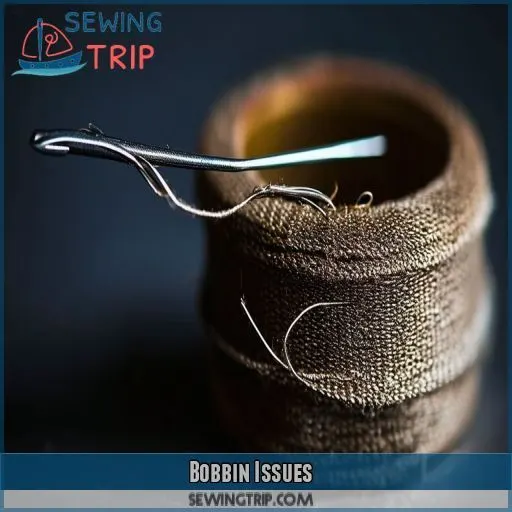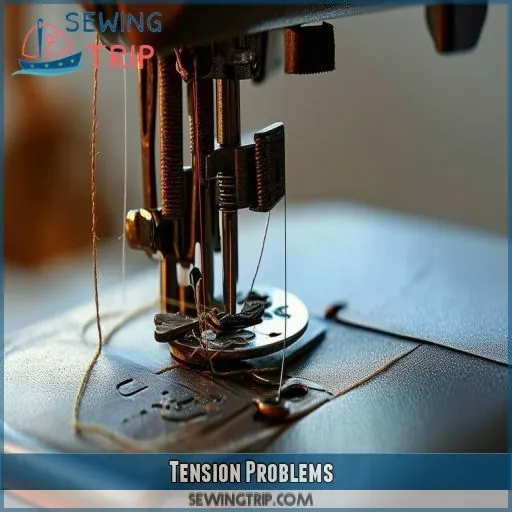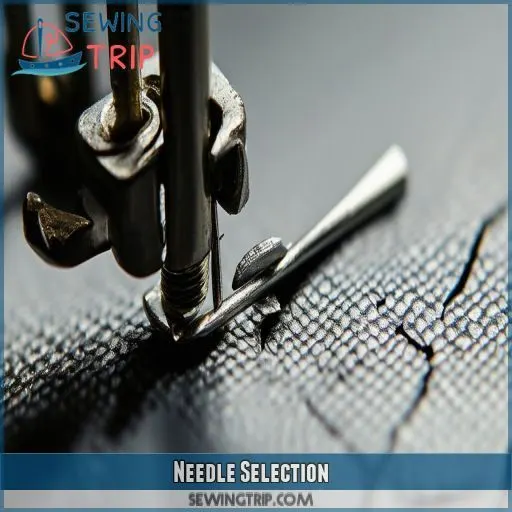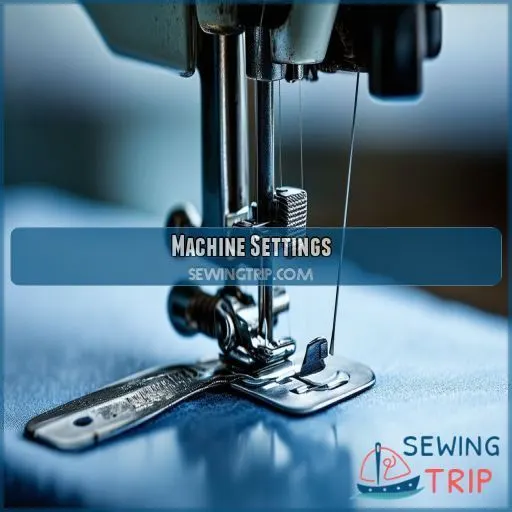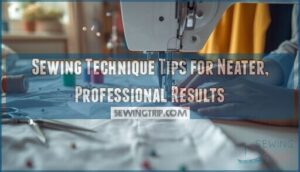This site is supported by our readers. We may earn a commission, at no cost to you, if you purchase through links.

The first reason has to do with threading and tension issues. If your thread is not secured on the spool pin, it can throw the tension off, causing the needle to bend. The same thing can happen if your thread wraps itself around a thread guide more than once.
You might also be using the wrong type of needle for the fabric, or the needle could be inserted incorrectly.
Another issue could be to do with the bobbin. If there’s an accumulation of lint in your machine’s bobbin, your needle could jam and bend.
To find out more about these issues and how to avoid them, read on.
Table Of Contents
Key Takeaways
- Sewing machine needles bend for a host of reasons, from threading and tension issues to bobbin woes and beyond. It’s a delicate balance, and any slight misstep can lead to a bent needle.
- Needle compatibility is key. Using the wrong needle for your fabric can be a recipe for disaster. It’s like trying to thread a needle with spaghetti – match the needle size to the fabric weight and choose the right needle type.
- Keep your machine well-maintained. Timing issues, worn-out parts, and lint accumulation can all conspire to bend your needle. Regular cleaning and oiling are a must.
- Take care with your needles. They’re sensitive souls and can bend easily if dropped or mishandled. Store them safely, check for damage, and replace them regularly to avoid sewing machine sadness.
Threading and Tension Issues
Ever wondered why your sewing machine needle keeps bending? It could be due to a variety of reasons, but let’s focus on one common issue: threading and tension problems.
From incorrect thread tension to improper threading techniques, these issues can lead to a bent needle and sewing machine woes.
Incorrect Thread Tension
We’ve all been there: you’re sewing along, and suddenly your needle bends. It’s frustrating, and it can be tough to pinpoint the exact cause. Well, one reason could be incorrect thread tension. Here’s what you need to watch out for:
- Tension settings: If your top thread tension is too tight, it can cause the needle to bend. Think of it like a tug-of-war; the thread and fabric are pulling against each other, and the poor needle is caught in the middle.
- Thread path: Make sure your thread is following the correct path through the tension discs. A stray thread can cause tension issues and put extra pressure on the needle.
- Spool pin: A tight spool pin can affect thread tension. Think of it like a tightrope walker—too much tension on the line, and they’ll (or in this case, your needle) will bend.
- Eye of the needle: Be careful not to pull your thread too tight when threading the needle. It’s a delicate balance, and too much tension can lead to bending.
Improper Threading Technique
You might be wondering why your sewing machine needle keeps bending. Well, one reason could be improper threading technique. It’s like trying to thread a needle with a piece of spaghetti—it’s just not gonna work!
Make sure you follow the correct thread path and tension guide. Check your machine’s manual for the proper threading order. Also, make sure the spool tension is correct and you’re using the right thread type. Improper threading can lead to tension issues and, eventually, a bent needle. So, take your time and thread that baby like a pro!
Needle Compatibility and Handling
Are you sewing along, minding your own business, when suddenly—snap! Your needle bends, and you’re left wondering what went wrong. It’s time to talk about needle compatibility and handling.
It’s not just about choosing the right needle for the job; it’s also about treating your needles with care. A little knowledge goes a long way toward preventing bent needles and keeping your sewing machine humming along happily.
Needle Size Mismatch
If your needle bends, it might be because you’re using the wrong size for your fabric. Here’s a quick checklist to avoid this:
- Match the needle size to the fabric weight: Using a needle that’s too fine for heavy fabric or too heavy for lightweight fabric can lead to bending.
- Choose the right needle type: Different needles are designed for specific fabrics. Using the wrong type can cause issues.
- Replace old needles: Older needles can become weakened and more prone to bending, so it’s important to replace them regularly.
- Handle with care: Needles can bend easily if dropped or mishandled, so always treat them with care.
Needle Material Incompatibility
Needle material matters. A lot.
Using the wrong type of needle for your fabric can lead to bending.
For instance, if you’re working with a delicate fabric, a ballpoint needle is ideal as it glides smoothly without damaging the fabric.
But if you’re sewing denim or canvas, you’ll need a stronger needle like a denim or jeans needle to handle thicker, tougher material.
Dropping or Mishandling Needles
Dropping or mishandling needles is a common issue that can lead to a bent needle. Here are some tips to avoid this:
- Be Careful With Needle Handling: Always handle needles with care. Dropping a needle can cause microscopic bends or burrs that may affect your sewing.
- Needle Storage: Store needles in a safe place when not in use. A magnetic case or needle cushion prevents drops.
- Compatibility: Use the right needle for your machine and fabric. Incompatible needles lead to mishandling.
- Regular Checks: Inspect needles for damage or bending. A worn needle is more likely to break.
Fabric Type and Thickness
You might be wondering why your needle keeps bending, and the fabric you’re using could be the culprit. It’s time to talk about how fabric type and thickness can impact your sewing machine needle.
Thick or Dense Fabrics
Let’s talk about fabric choice.
If you’re sewing through thick or dense fabrics, your needle might bend due to the extra pressure and resistance. Imagine trying to push a needle through a stack of jeans—it takes some muscle!
To avoid this, choose the right needle size and type for the fabric. Heavier fabrics need stronger, thicker needles.
Also, consider adjusting your stitch length and sewing speed. Slower speeds and longer stitch lengths can help the needle penetrate thicker fabrics without bending.
Delicate or Lightweight Fabrics
On the flip side, if you’re working with delicate or lightweight fabrics, your needle can bend due to incorrect needle choice or stitch length.
Go for a smaller needle size and adjust your stitch length accordingly. You don’t want to be poking more holes in your fabric than necessary! A simple switch-up can save your needle from bending and your fabric from tears.
Sewing Machine Maintenance
Sewing machine maintenance is key to keeping your needles straight and your stitches smooth. Let’s take a closer look and explore how timing issues and worn-out parts can lead to that frustrating bend.
Timing Issues
Sewing machine timing issues can be a real headache, but don’t stress—you can troubleshoot and fix these problems with a bit of know-how. Timing issues often arise from misaligned or poorly installed parts, or even a build-up of debris.
Here’s a quick machine timing check: open the switch plate and move the handwheel to see if the thread hooks into the fabric smoothly. If the hook passes through or underneath the eye of the needle, your timing is off. The hook should pass above the eye. If the timing’s off, adjust your needle position based on the hook’s rotation: clockwise means move the needle to the right; counterclockwise means move it to the left.
If that doesn’t work, try adjusting the needle bar height, and refer to your manual for guidance.
Worn or Damaged Components
Your machine’s age and condition matter.
Older machines might’ve worn gears or other parts that affect needle alignment and tension.
Regular maintenance, including oiling routines and cleaning parts, is key.
Check your machine’s timing, especially if it’s an older model.
If it’s off, the needle can hit the hook at the wrong moment, bending or breaking.
Keep your machine well-maintained and oiled to prevent this.
Also, be sure to clean your machine regularly.
Bobbin Issues
Bobbin issues are a common reason for sewing machine needle bending. From inserting the bobbin incorrectly to neglecting the buildup of lint, these tiny components can cause big problems if not handled right.
Bobbin Inserted Incorrectly
Let’s talk about another common reason needles bend: bobbin issues. Here’s the lowdown on what can go wrong and how to fix it:
Sometimes, it’s the simplest things that cause the biggest headaches. If your bobbin isn’t inserted correctly, it can lead to needle bending. Here’s a quick checklist to make sure your bobbin is in the right place:
- Make sure the bobbin is facing the right way: Most bobbins have a right and wrong side. Check your machine’s manual to see which way the bobbin should be facing.
- Fully insert the bobbin: Push the bobbin all the way into its case. A partially inserted bobbin can cause uneven thread tension and, you guessed it, needle bending.
- Don’t force it: If the bobbin doesn’t slide in smoothly, something’s not right. Check for any obstructions or issues with the case.
Lint Accumulation in Bobbin Case
Another reason your needle might be bending is due to accumulated lint in the bobbin case. Over time, lint and thread debris can build up in the bobbin case, causing friction and resistance. This can lead to increased tension and pressure on the needle, resulting in bending or breakage. To prevent this, it’s important to regularly clean your bobbin case.
Here’s a quick tip: use a small brush or cotton swab to gently remove any lint or thread buildup from the bobbin case. This simple maintenance routine will help keep your machine running smoothly and prevent needle bending caused by lint accumulation.
Tension Problems
Have you ever noticed your sewing machine needle bending and wondered, "Why me?" Tension problems could be the culprit. It’s like that time your friend pulled a little too hard on your homemade bracelet, and the thread snapped. Oops!
Your Thread Tension is Too Tight
Another reason for a bent needle could be that your thread tension is too tight. This issue can cause the needle to bend or break as it struggles to move the thread through the fabric. It’s like trying to pull a tightrope that’s stretched too taut.
Imagine you’re sewing along, and suddenly it feels like your machine is fighting against you. The thread is so tight it could snap at any moment. That’s a sure sign something’s up with your tension settings.
When your thread tension is too tight, it puts extra strain on the needle, increasing the chances of it bending or breaking. So, if you notice this issue, it’s time to loosen up that tension and let your needle breathe!
Tension Not Adjusted Correctly
Tension issues can also arise from incorrect tension adjustments. Here are some common problems and solutions:
- Your top thread tension could be too tight, causing the needle to bend or break. Loosen the top thread tension slightly and test on a scrap of fabric before continuing with your project.
- The bobbin thread tension might be too loose, leading to similar issues. Adjust the bobbin thread tension by tightening it a little at a time until you find the sweet spot.
- If you notice the bobbin thread showing on the top of your fabric, it’s a sign that your tension needs adjusting. Tweak the settings until the balance is restored.
Needle Selection
If your needle is bending, it might be time for a swap. Needle selection matters, and using the wrong needle for your fabric can lead to some sewing machine headaches. Let’s get you on the right track with a quick guide to choosing the right needle.
Incorrect Needle for Fabric Type
Choosing the right needle for the fabric you’re working with is super important. If the needle is too heavy for delicate or lightweight fabrics, it can easily bend or break. On the other hand, if the needle is too fine for thick or dense fabrics, it might struggle to penetrate and bend under pressure.
The trick is to match the needle size to the fabric weight. Generally, finer fabrics call for smaller needles, while heavier fabrics need larger ones. But it’s not just about size—fabric type matters, too. For instance, ballpoint needles are designed for knit fabrics, while denim needles are made for denim.
Needle Out of Position
A wonky needle position can lead to bending and breakage. Here’s how to get your needle in tip-top shape:
- Double-check your needle placement: Make sure the needle is inserted correctly and at the right depth.
- Adjust for fabric thickness: Use the right needle size for your fabric. Too thin, and it might bend; too thick, and it could snap.
- Prevent bending: Keep an eye on your needle’s position during sewing. A slight nudge can throw it off, leading to bending or breakage.
- Keep it clean: Lint and debris can build up, pushing your needle out of alignment. Regular cleaning keeps everything running smoothly.
- Replace regularly: Needles wear out, so swap them before they become damaged or bent.
Machine Settings
Sometimes, it’s the little things that make a big difference. The wrong stitch plate or pressure foot can lead to a bent needle. It’s like trying to fit a square peg in a round hole – it just won’t work.
| Issue | Solution |
|---|---|
| Wrong stitch plate | Use the right plate for your stitch type. It’s like a match made in heaven. |
| Pressure foot mismatch | Change it up! Different stitches need different feet. |
| Needle position woes | Get that needle in the right spot. It’s all about precision. |
| Threading troubles | Take your time and thread that machine like a pro. No shortcuts! |
Frequently Asked Questions (FAQs)
How do you fix a bent sewing needle?
You can try straightening a bent needle with pliers, but this might weaken it. It’s safer to replace the needle with a new one to avoid damaging your machine.
Can you use a bent needle on a sewing machine?
Nope, don’t do it. A bent needle can mess with your machine’s timing, which is a pain to fix. Plus, it’ll affect your stitch quality and could even damage your fabric. Not worth the risk, mate.
Why are some sewing needles curved?
Curved needles are easier to control and can reach angles that straight needles can’t. They’re often used for upholstery, fabric boxes, crafting, and more. Curved needles are also easier on the hands, especially for those with arthritis or frozen joints.
How do you bend a needle straight?
You can try to straighten a sewing needle with pliers, but this can weaken the needle, and it may snap. Another method is to gently tap a bent needle with a small hammer on a metal block.
Can sewing machine needles be reused?
Sewing machine needles shouldn’t be reused as they can become dull and ineffective. It’s recommended to use a new needle for each project or when sewing different materials. Needles should be replaced every 5-6 projects.
What type of sewing machine needle should I use?
The needle type depends on the fabric. Universal needles are the most common and pierce most medium-weight fabrics. Knit fabrics need a ballpoint needle, while leather requires a sharp, leather needle.
How often should I change my sewing machine needle?
You should change your sewing machine needle after every 10 hours of stitching. This will keep your needle sharp and prevent it from dulling, which can cause issues with your fabric and thread tension.
Can you sew over pins?
Sewing over pins is like playing with fire—risky business. One slip and you could damage your fabric, machine, or yourself. So, can you do it? Yes, but proceed with caution. Always use fine, sharp pins, and never sew over them at high speed. Slow and steady wins the race here.
Can you sew over zippers?
Sewing over zippers is possible, but it’s tricky. You need to go slowly and avoid hitting the zipper teeth with your needle, which can cause it to break. Sewing over plastic or nylon zippers is easier than metal ones.
Conclusion
Sewing machine needles are delicate, and like a house of cards, one wrong move can bring them tumbling down.
We’ve explored seven reasons why your needle might’ve bent, from threading tension to bobbin woes and beyond.
With this guide, you’ll be able to diagnose the issue and get your machine humming along nicely again.

